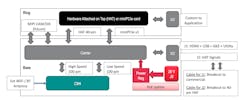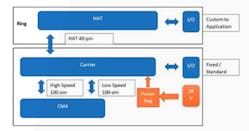This article appeared in Electronic Design and has been published here with permission.
What you’ll learn:
- What is a Raspberry Pi Compute Module?
- How to use a Raspberry Pi in a rugged environment.
Happy Pi Day!
Its March 14, or 3-14, also known as Pi Day. It’s when my alma mater, Georgia Tech, holds the Pi Mile Race, essentially a 5K race down the streets of Atlanta. This year is the 50th annual race.
In 2022, we also can celebrate Curtiss-Wright’s release of the Parvus DuraCOR Pi (Fig. 1). This little box houses a Raspberry Pi Compute Module 4. The compute modules provide a more rugged and compact solution than the conventional Raspberry Pi platforms, which are often oriented toward prototyping. Many developers have used these platforms in products, but these tend to go into environments that aren’t as demanding, such as homes and offices.
Raspberry Pi compute modules generally find homes in industrial applications. Sfera Labs’ Iono Pi Max is a programmable logic controller (PLC) that’s powered by a Raspberry Pi computer module. It’s designed for industrial and production line applications.
The Parvus DuraCOR Pi could be used in those environments, especially when the device needs to be in the field. All of the other components are designed to handle rugged environments that are wet, dirty, and messy.
The Raspberry Pi Compute Module 4 integrates a Broadcom 1.5-GHz BCM2711 with a quad-core Arm Cortex-A72 compute complex. It has MIPI camera interfaces, display interface, Gigabit Ethernet with IEEE 1588 support, 2.4- and 5.0-GHz IEEE 802.11 b/g/n/ac Wi-Fi support, and Bluetooth 5.0 and BLE support. Any of these external interfaces can be used or disabled on the Parvus DuraCOR Pi.
The module has up to 32 GB of eMMC and up to 8 GB of LPDDR4-3200 SDRAM with ECC support. The Curtiss-Wright platform utilizes a CM410832 compute module with 1-GB SDRAM and 32 GB of eMMC flash.
The DuraCOR family is designed to be stackable, so it’s possible to add a Raspberry Pi “hat” peripheral adapter (Fig. 2). This increases the height of the unit but retains the sealed, rugged nature of the system. A stackable variant takes advantage of the single-lane, PCI Express (PCIe) interface provided by the compute module, allowing a Mini-PCIe socket to be used for expansion. This could house a peripheral interface or a solid-state disk.
The family targets very rugged applications, such as avionics as well as manned and unmanned vehicles. The USFF can fit into small drones that are often prototyped with a conventional Raspberry Pi. However, it’s not practical to ship real product without moving to more rugged solutions like the DuraCOR Pi. The USFF unit can be used in standalone deployments or as part of a distributed network solution.



